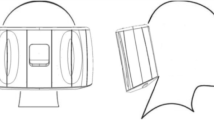Abstract
This double-blind, placebo-controlled study assessed the efficacy of 4 weeks of impulse magnetic-field therapy (16 Hz, 5 μTs), delivered through a small device, for different types of headache and migraine. Eighty-two patients were randomly assigned to receive either active treatment or placebo (n = 41 each) and were characterized according to one of seven diagnoses (migraine, migraine combined with tension, tension, cluster, weather-related, posttraumatic, or other). Efficacy was assessed in terms of duration, severity, and frequency of migraine and headache attacks, as well as ability to concentrate. Data for77 patients were analyzed. In the active-treatment group, all assessed criteria were significantly improved at the end of the study (P<.0001 vs baseline and placebo). Seventy-six percent of active-treatment patients experienced clear or very clear relief of their complaints. Only 1 placebo-patient (2.5%) felt some relief; 8% noted slight and 2% reported significant worsening of symptoms. No side effects were noted.
Similar content being viewed by others
References
Guyton AC, Hall JE. Somatic sensations, II: pain, headache, and thermal sensations. In:Textbook of Medical Physiology. 9th ed. Philadelphia: WB Saunders; 1996:617–619.
Celentano DD, Stewart WF, Lipton RB, Reed ML. Medication use and disability among migraineurs: a national probability sample.Headache. 1992;32:237–238.
Stewart WF, Shechter A, Rasmussen BK. Migraine prevalence: a review of population-based studies.Neurology. 1994;44(6,suppl 4):S17-S23.
Stewart WF, Lipton RB. Migraine headache: epidemiology and health care utilisation.Cephalalgia. 1993;3(suppl 12):41–46.
De Lissvoy G, Lazarus SS. The economic cost of migraine: present state of knowledge.Neurology. 1994;44(6, suppl 4):S56-S62.
Böhmig U.Kopfschmerz und Migräne. Vienna: Orac Verlag; 1988.
Kniep P.Migräne und Gesundheit. Munich: Herder; 1987.
Pfaffenrath V.Was ist Gesichert in der Therapie?Der chronische Kopfschmerz—Spannungskopfschmerz und Schmerzmittelmiflbrauch. Munich: Arcis Verlag; 1988.
Sicuteri F, Del Bianco PL, Anselmi B. Morphine abstinence and serotonin supersensitivity in man: analogies with the mechanism of migraine?Psychopharmacology, Berlin. 1979;65:205–209.
Raskin VH. Headache. In: Wilson JD, Braunwald E, Isselbacher KJ, et al, eds.Harrison’s Principles of Internal Medicine. 12th ed. New York: McGraw-Hill; 1991:108–115.
Silberstein STD. Practice parameter: evidence-based guidelines for migraine headache (an evidence-based review).Neurology. 2000;55:754–763.
National Institute of Neurological Disorders and Stroke. NINDS headache information page. Bethesda, Md: National Institutes of Health; 2000. Available at: www.ninds.nih.gov.
Oleson J. Classification and diagnostic criteria for headache disorders. Cranial neuralgias and facial pain.Cephalalgia. 1988;8(suppl 7):19–28.
Tiuriaeva AA, Ponizovskii VM, Akimov GL. Effects of alternating field on healing of ulcers of the lower extremities.Vestn Khir Im I I Grek. 1977;119:84–85.
Barnothy M.Biological Effects of Magnetic Fields. New York: Plenum Press; 1969.
Bassett CA, Pilla AA, Pawluk RJ. A non-operative salvage of surgically-resistant pseudoarthroses and non-unions by pulsing electromagnetic fields. A preliminary report.Clin Orthop. 1977; 124:128–143.
Bergsmann O. Selektive Feldtherapie bei pseudoradikulären Symptomen.Manuella Med. 1983; 21:139.
Cameron H, et al. An examination of the effects of pulsed magnetic fields on knee swelling following total knee replacement. Presented at: International Congress on Foot and Hand Surgery; 1981; São Paulo, Brazil.
Ehrmann W, et al. Therapie mit ELF-Magnetfeldern.Z Phys Med. 1976;4: 161–170.
Evertz U, König H. Pulsierende magnetische Felder in ihrer Bedeutung für die Medizin.Hippokrates. 1977;1:16.
Hainovici N. Beeinflussung der Kallusbildung unter der Behandlung mit niederfrequenten gepulsten magnetfeldern.Therapiewoche. 1987;30:4619–4631.
Watson J, Downes E. Clinical aspects of the stimulation of bone healing using electrical phaenomena.Med Ant Biot Ent Comp. 1979;17:261.
Warnke U. Grundlagen zu magnetisch induzierten physiologischen Effekten.Therapiewoche. 1980;30:4609–4616.
Author information
Authors and Affiliations
Rights and permissions
About this article
Cite this article
Pelka, R.B., Jaenicke, C. & Gruenwald, J. Impulse magnetic-field therapy for migraine and other headaches: A double-blind, placebo-controlled study. Adv Therapy 18, 101–109 (2001). https://doi.org/10.1007/BF02850298
Issue Date:
DOI: https://doi.org/10.1007/BF02850298




